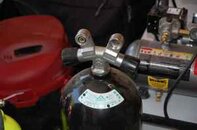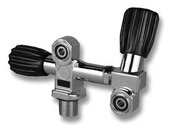Why not both on the left. Or LPI or the right and SPG on the left
Because the right post is where they have their primary... and which they'll shut-down if that primary free-flows... meaning they'll also lose their LPI and SPG.
Following the free-flow, they'll be unable to confirm their gas. Naturally, they should be on their way up anyway... but not knowing adds stress.
They'll also have to orally inflate the BCD, which adds task-loading to an already stressed diver.
Never quite understood the thinking that H- or Y- valves give you real redundancy.
I agree. It's
limited redundancy - specifically, it is a redundant regulator,
not a redundant air source. Any issue with the cylinder, cylinder valve or gas contents (
contaminated air) will still cause loss.
That mitigates against more prevalent failures (
free-flow, burst hose, second stage failure), but not against more rare cylinder/valve failures. Personally, I don't agree with it for deco/overhead (
even limited) for that reason. For recreational, non-overhead, divers it presents a relatively cost effective method of mitigating specific risks.







